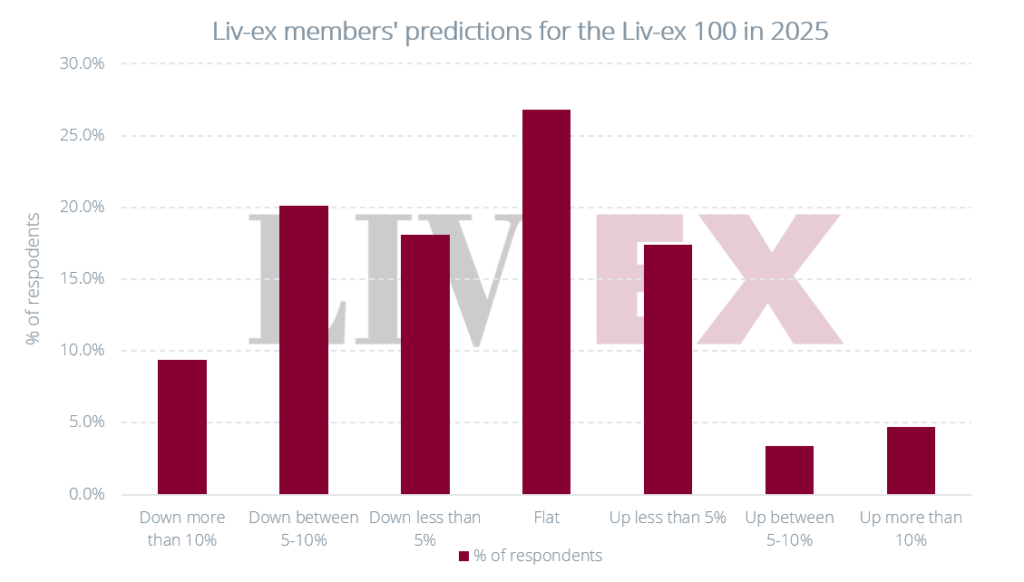February 2025 Wrap-Up
Optimism Is in the Air—& Everything Else That Happened in the World of Wine in February
With March and spring ahead and winter behind us, is it time for optimism?
Well, Liv-ex certainly thinks so.
Liv-ex Is Optimistic
Liv-ex reports that the bid:offer spread of the Fine Wine 50 has hit a two-year low, while traded volumes have reached their highest levels since 2021. This indicates greater alignment between buyers and sellers, suggesting increased market confidence because a tight bid-offer spread means that the difference between the highest price a buyer is willing to pay (bid) and the lowest price a seller is willing to accept (offer) is small. Since the start of 2024, the spread has narrowed, dropping below 8% for the first time since mid-2022.
The tighter spread has coincided with a rise in traded volumes. In the first three weeks of February, more Fine Wine 50 components changed hands than in all of January, which itself saw a 33.8% increase over December. If this trend continues, February is set to record the highest trade volumes since July 2021.
In addition, Liv-ex members were surveyed on their outlook for the Fine Wine 100 Index by the end of 2025. On average, respondents predicted a 1.9% decline, with the index expected to close at 320, compared to a 9.1% drop in 2024. This forecast closely aligns with the index’s 2018 peak of 316.
What do In the Mood for Wine readers think? Share your view in the poll below!
“Why fine wine and fancy art have slumped this year?” — The Economist
Luxury assets have had a rough year. We know that. It’s not just wine. While the Liv-ex Fine Wine 1000 shows fine wine prices fell 12% in 2024, according to Art Market Research, investors in art lost an average of 16% in 2024. Diamonds dropped nearly 20%, and collectible cars remained flat.
This downturn follows years of soaring prices, particularly during the pandemic, when high-end goods saw unprecedented demand.
Despite global GDP growth (3.2%), booming stock markets, and a rising ultra-rich population (expected to reach 86 million millionaires by 2027), luxury assets have struggled.
Why?
The Economist highlights two reasons.
Traditional financial assets have offered higher returns. The MSCI World Index is up 17%, Bitcoin has surged 140%, and even short-term Treasuries have delivered 5%+ returns.
Geopolitics has also played a (minor) role. Conflicts in Ukraine and the Middle East, uncertainty over the U.S. election, and fears of trade wars (like Trump’s 2019 25% wine tariffs) have dampened demand. Meanwhile, China’s slowdown—marked by a property crisis and government crackdowns on wealth—has hurt luxury consumption, especially Burgundy wines, whose prices have plunged 30% in two years.
So, if all passion assets have been in decline since 2023, perhaps fine wine’s downturn isn’t a structural issue, but part of a broader interest rate-driven cycle?
Higher interest rates hurt assets with high cost of carry (see here for an explanation), making fine wine less attractive unless producers absorb more of the risk—a shift that will take time.
Demographics could also reshape demand, as younger buyers reject En Primeur, forcing producers to rethink pricing and maturation strategies.
The rise of digital marketplaces will enhance liquidity and price transparency, squeezing intermediary margins and accelerating price discovery. Whether this leads to higher or lower returns remains uncertain, making speculation risky.
Any recovery will likely be slow and volatile, as investors prioritise capital preservation over speculative gains.
Why Invest In Fine Wine? A Forgotten Asset Class — A Presentation To The CFA Madrid
The CFA (Chartered Financial Analyst) designation is one of the most rigorous credentials for investment professionals. It requires passing three six-hour exams covering everything from accounting and ethics to asset classes and portfolio management.
I’ve been a CFA charterholder since 2017, but fine wine was never part of the curriculum.
At CFA Madrid, I had the opportunity to introduce fine wine as an alternative investment, discussing why it deserves attention and how investors can approach it strategically.
Among the things that we discussed, ageability is key. Wine is the only asset that improves over time at no extra cost.
(We also tasted a ‘78 Prado Enea from Bodegas Muga. It was nothing like I expected—proof of the magic of drinking old vintages.)
“The Best of Rioja 2025” Event — by Tim Atkin MW
Rarely does a wine critic take the bold step of organising an event exclusively featuring (what he thinks are) the top bodegas of a vintage—those he has ranked as First, Second, and Third Growths, along with a select group of ‘Rising Stars’—producers he believes are the ones to watch. Most critics steer clear of such rankings, either to avoid backlash from excluded estates or simply to not rock the boat.
But this is Tim Atkin’s tenth, deliberately controversial attempt to classify Rioja’s best producers, loosely inspired by the 1855 Bordeaux Classification. His list ranks wines into five bands of 20 (First to Fifth Growths), plus a group of 100 Crus Bourgeois.
However, there’s a difference, Atkin explains: “Unlike the 1855 Classification, quality is the only criterion I use, although some of my top wines are certainly expensive, too.” He clarifies that “[…]these are my favourite producers, chosen on the basis of tasting and, in most cases, one or more visits to their bodegas. I hope that the selection, which includes a mixture of producers (modern, traditional, large, small, recent and well- established), will again stimulate debate and encourage people to try the best wines that Rioja has to offer.”
Why is it important for the readers of this publication?
Much has been said about the importance of wine scores. Most recently, Simon J Woolf in “Are Wine Scores a Waste of Time?” questioned their true value for consumers. Originally popularised by Robert Parker’s 100-point system, scores are widely used in the industry but remain subjective, inconsistent, and often misleading.
That said, while I’m also skeptical of most wine scores, I believe a wine critic’s role extends beyond scoring—it’s about guiding both consumers and the trade toward the most exciting wines, producers, regions, and vintages.
That’s why I see Tim Atkin’s classification as invaluable for collectors and investors.
“Bierzo Reborn”, Decanter — by Beth Willard
At a dinner in Madrid, Beth Willard introduced me to José Antonio García’s wines and mentioned that she was writing a Decanter piece on Bierzo, focusing on its quality and its potential to be recognised as one of the world's great terroirs. Aside from being fluent in Spanish and French—and who knows how many other languages—she’s also a great taster and, even better, an opinionated one. And that’s exactly what I like.
Her perspective got me thinking about a question I’m often asked —can fine wine investors look beyond Bordeaux?
Well, I certainly hope so.
Investors and collectors remain largely focused on traditional French regions and winemakers. However, I’ve noticed some smaller, more adventurous merchants starting to push wines from new regions—not just the occasional bottle, but as a concept.
However, it’s crucial that independent, authoritative voices like hers lead the conversation on what constitutes fine wine. Right now, that narrative is largely controlled by merchants and La Place, who remain fixated on pushing the same old Bordeaux names. This leaves collectors with a single, biased perspective—all they hear is Bordeaux, Bordeaux, Bordeaux.
Highlighting new and exciting regions like Bierzo is a step toward diversifying the conversation.
If successful, it could shift attention first among merchants and eventually among consumers. From a investor’s perspective, understanding a region’s wine ageability is key—yet often overlooked. To truly engage serious buyers, showcasing 10+ year-old wines would make a huge difference. It’s one thing to talk about ageability; it’s another to prove it.
And frankly, now is the perfect moment. Bordeaux has alienated investors with En Primeur pricing that, at this point, is nothing short of an insult to their intelligence.
Bolgheri 2022 Vintage Tasting — Organised By Nelson Pari & Federico Moccia at 67 Pall Mall
Nelson Pari & Federico Moccia hosted a tasting of the latest Bolgheri vintage at 67 Pall Mall.
Talking about Bolgheri 2022 is tricky.
Why?
Because 2019, 2020 and 2021 were such exceptional vintages—widely praised by critics—that now everyone seems eager to dismiss 2022, 2023, and 2024 before even tasting them.
But as always, Pari and Moccia’s motto is taste first, then judge.
“Surprisingly, both Federico Moccia—head sommelier of 67 Pall Mall—and I personally prefer the 2022 vintage to 2021,” says Pari.
“The noses tend to lean towards red fruit, offering plenty of expressiveness, while the palates remain strikingly austere. These are wines built for longevity, easily capable of aging 15 to 20 years. And yet, they come from a challenging year—one that, on paper, shouldn’t have produced wines of this calibre. The first half of the year was marked by rain and frost, while the latter half saw extreme drought. Few would have expected such remarkable results.”
They’re particularly excited to discuss these wines because, in a region often framed as a battle between Sassicaia and Ornellaia, 2022 presents a fascinating shift. Pari mentioned that what started as a top 3 blind tasting of the vintage quickly expanded to a top 14—a testament to the denomination-wide success of 2022. In addition, this year, the stylistic differences between Sassicaia and Ornellaia are not as clear-cut. The old elegance versus power narrative doesn’t apply to 2022. Instead, the region's expressiveness is deepening, with wines speaking more distinctly of their terroir. Ornellaia is evolving towards a character reminiscent of “Léoville-Las Cases of the Mediterranean”, while Sassicaia is embracing an ethereal, forest-floor complexity, a bold response to following up its legendary 2021 vintage—introducing an incredible innovation.
Piastraia deserves special mention. My notes on the 2021 vintage were glowing (see below), but 2022 seems to have delivered something even more compelling.
And Finally… See You In London 👋🏻
For those in London, Wine Owners is hosting an event on 26th March 2025 at Davy’s Wine House in Holborn, and I’m delighted to be joining as a speaker.
I’ll be sharing my experience navigating challenges in the Chinese market and the evolution of consumer behavior. More importantly, I’ll explore how these insights are especially relevant today, as structural shifts reshape the wine market and businesses must adapt to stay ahead.
I hope to see you there—make sure to RSVP here.
Thanks for reading.
Sara Danese
One more thing…
If you like this format and want to contribute, send me any articles or charts you find interesting at sara@inthemoodforwine.com.
Thanks again.
SUPPORT ITMFW
If you appreciate In the Mood for Wine and its mission to help you understand fine wine as an investable asset class, consider becoming a supporter with a paid subscription. You'll unlock exclusive perks, surprises, etc.—while ensuring the free edition remains accessible to all.
Can’t (or don’t want to) pay for a supporter sub, for any reason whatsoever? Then share it widely!

















Thanks for referencing my article Sara. And I'm happy to hear that you see the wine critic's going beyond scores. Here here!